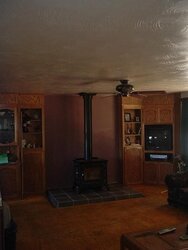Ok I have two questions first topic,
I purchased some Metal Fab DW pipe to grow from the stove to the Manufactured chimney's ceiling support box. The instructions say to secure the sections together with screw, but it did not come with screws and the shop I purchased it from does not carry them. So what type of screws work best, what length of screws (I assume the intent is to only penetrate the outerwall of the pipe and not the inner wall). Do you pain the heads to blend in (the Pipe manual says Stove Bright 1990). Should the DW section of stove pipe screw to the stove pipe chimney adaptor, and what about the top of the stove.
Now I just set my T6 in place, and my question is this, I do not plan on using outside combustion air, so do I still need to Knock out the 4" Knock out on the bottom of the stove? My interpretation is "NO" it is not required, but I may be wrong.
I realize there are several questions in the above paragraphs, your experiences and opinions are greatly appreiceated.
aussieblake
I purchased some Metal Fab DW pipe to grow from the stove to the Manufactured chimney's ceiling support box. The instructions say to secure the sections together with screw, but it did not come with screws and the shop I purchased it from does not carry them. So what type of screws work best, what length of screws (I assume the intent is to only penetrate the outerwall of the pipe and not the inner wall). Do you pain the heads to blend in (the Pipe manual says Stove Bright 1990). Should the DW section of stove pipe screw to the stove pipe chimney adaptor, and what about the top of the stove.
Now I just set my T6 in place, and my question is this, I do not plan on using outside combustion air, so do I still need to Knock out the 4" Knock out on the bottom of the stove? My interpretation is "NO" it is not required, but I may be wrong.
I realize there are several questions in the above paragraphs, your experiences and opinions are greatly appreiceated.
aussieblake



